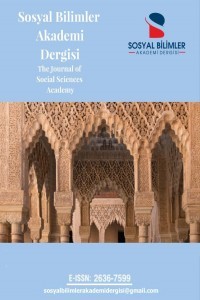CHRISTOPH RANSMAYR'İN SON DÜNYA ROMANINDA POSTMODERN ÖZELLİKLER
Christoph Ransmayr'ın “Son Dünya” romanı, postmodern roman özelliklerini taşıyan önemli bir eser olarak değerlendirilmektedir. Roman, döneminin anlatım tekniklerine yabancılaşmış ve kendine özgü bir anlatım diline sahip olan bir şairin, sürgün hayatının sonunu beklerken ücra bir kentte hayat hikayesinin anlatılmasıyla belirgindir.
Romanın postmodern özellikleri arasında, klasik anlatı yapısının yerine doğrusal olmayan (non-lineer) bir anlatım tekniği kullanılması, gerçeklik kavramının sorgulanması, metinler arası referansların yoğun olarak kullanılması, anlatıcının güvenilirliğinin sorgulanması ve eser içindeki dil oyunları sıralanabilir. Ayrıca, Ransmayr'ın dil kullanımı da oldukça dikkat çekicidir. Anlatımındaki yer yer şiirsel ifadeler, okuyucunun anlamı çözümlemesini güçleştirmekte ve böylece postmodernizmin belirsizlik niteliği ile de uyuşmaktadır. Postmodern anlatım tekniği bakımından özellikle de dil kullanımı ve kurgusal olarak farklı bir gerçeklik anlayışının sorgulanması, okuyucuya farklı bir okuma deneyimi kazandırmakta böylece yapıtı dünya edebiyatında postmodern kategori içerisinde özellikli bir yere konumlandırmaktadır.
Anahtar Kelimeler:
Christoph Ransmayr, Postmodernizm, Son dünya, Metinlerarasılık, Eklektisizm, Gerçekliğin sorgulanması
POSTMODERN FEATURES IN CHRISTOPH RANSMAYR'S NOVEL “THE LAST WORLD”
Christoph Ransmayr's novel "Die Letzte Welt" is considered an important work with postmodern characteristics. The novel is evident that a poet, who has become estranged from the narrative techniques of their era and possesses a unique narrative language, awaits the end of their exile while their life story is being narrated in a remote city. Among the postmodern features of the novel is the use of non-linear narrative techniques instead of classical narrative structure, questioning of the concept of reality, the extensive use of intertextual references, questioning of the reliability of the narrator, and the use of language games within the work. Additionally, Ransmayr's use of language is quite remarkable. His occasional poetic expressions in the narration make it difficult for the reader to decipher the meaning, thus matching the ambiguity characteristic of postmodernism. In terms of postmodern narrative techniques, particularly the use of language and questioning a different understanding of reality in fiction, the novel offers readers a different reading experience and thus positions the work in a special place in world literature within the postmodern category.
Keywords:
Christoph Ransmayr, Postmodernism, Last World, Intertextuality, Eclecticism, Questioning of realty,
- Yayın Aralığı: Yılda 2 Sayı
- Başlangıç: 2018
- Yayıncı: Ali Ülvi ÖZBEY
